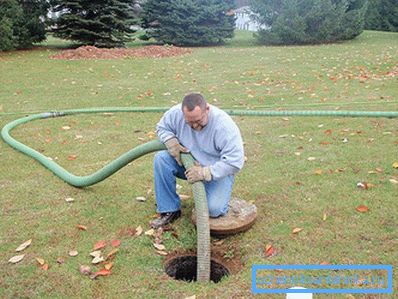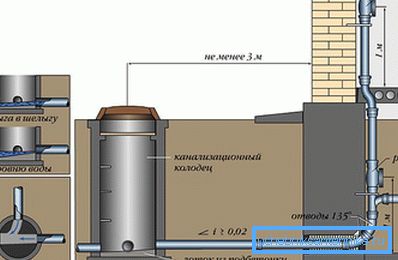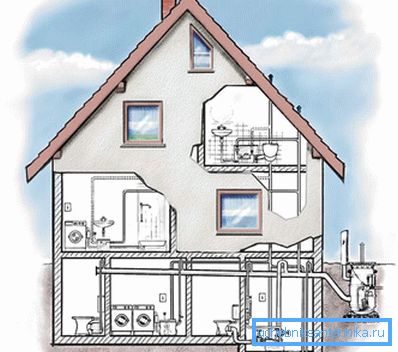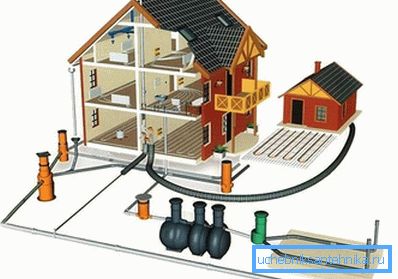Sewerage country house itself
Modern country houses are unthinkable without the benefits of civilization, like plumbing and sewage (including rain), but their owners often have to create comfort on their own. The lack of central water supply and sewer network is not an insurmountable obstacle, as they are replaced by autonomous installations. Proper arrangement of the sewer system can be entrusted to professionals, but this is not always a guarantee of quality and requires additional costs. The abundance of information and video, the availability of materials and the simplicity of their installation - these are the reasons why the sewerage of a country house does its own hands quite often.
What is included in the sewer system
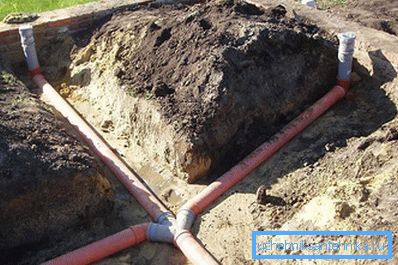
Local sewage system is a complex, including:
- internal equipment (plumbing fixtures and pipe wiring);
- the external highway serving for removal of drains;
- cesspit or septic tank to collect sewage.
The complexity of the system depends on the number of plumbing and its placement in the house. Its installation requires compliance with all technological and sanitary standards. The general scheme of sewage is divided into two circuits - internal and external, each has its own peculiarities and nuances in working with each of them.
Design
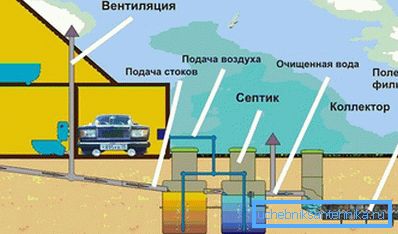
Sewage project preparation is carried out simultaneously with the general plan of the house. Plumbing should be placed compactly to be able to connect it to one collector or riser, if the building has several floors. The diagram shows all plumbing equipment, the location of the pipes connected to it, and the entry of pipes into the house. When drafting a project, external sewers are taken into account. The line from the house to the septic tank must lie below the level of freezing. With a complex system of connecting devices or having a pool, it is difficult to independently create a competent sewage project. Errors in the scheme turn out to be significant problems, and will require expensive rework, so it is better to immediately entrust the work of the plan to professionals. According to the project estimates for the purchase of material.
Internal circuit device
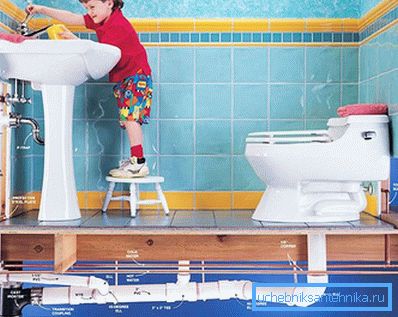
Installation of sewage system inside the house is made of plastic pipes with a diameter of 110, 50 and 32 mm. Smaller diameter is set for the withdrawal of sinks, showers, baths.
For installation of the riser and connection to the toilet, a pipe O 110 mm is used.
Propylene or PVC pipes have a smooth surface that does not impede drains, they do not overgrow and do not corrode. The material for interior work is made of gray plastic, this is important, because it is not suitable for laying a street line.
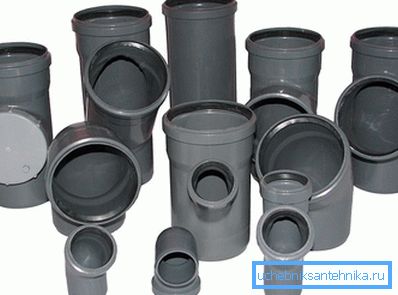
Drainage through sewer pipes moves by gravity, so you need to create a slope of at least 2 cm by 1 m. Otherwise, the system will function poorly.
External part of the system
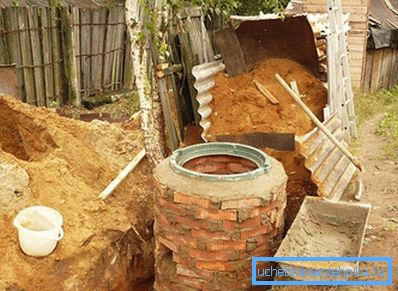
The external contour includes pipes transporting drains to the receiver and storage tank. The choice of autonomous sewage depends on the amount of wastewater and the wealth of the owners. The sewerage device of a country house can be as follows:
- The cesspool, at the bottom of which is arranged a filter of sand and rubble. Its walls are made of brick or concrete. This option is designed for a small amount of water and is dangerous to the surrounding area due to the possibility of clogging by drains. The principle of the pits - the water seeps through the sedimentary rock, and the solid fraction remains at the bottom. After a while they need to pump out. This is the most economical and requires a minimum cost of arrangement of sewage disposal.
- Two-chamber septic tank consisting of two or three wells. The first section of the structure is sealed; for its devices, concrete rings are used or the floor and walls of the excavated pit are poured with a coupler. In two places - at the entrance of the discharge pipe from the house and at the place of overflow, holes are made. In this part, the effluent will be divided into water and solid fractions. The use of reinforced concrete rings speeds up the installation of a septic tank; depending on the size of the well, it is enough to stack 2–3 rings on top of each other. They are connected by metal fittings, the joints are covered with cement mortar. The water clarified in the first compartment enters the next chamber through the overflow pipe. This part does not have a sealed bottom, it is replaced by a layer of sedimentary rock up to 50 cm. Such a settling tank requires a rare purification by an as-spraying machine and will cope with a large volume of wastewater. From above the septic tank is closed by a slab with a hatch. If you add aerobic bacteria to the sump, the cleaning process will accelerate and the unpleasant smell will decrease.
- Storage tank made of plastic. The safe tight tank which demands a minimum of work on the device. It is enough to dig out a ditch of the necessary size and to connect a sewer pipe. The disadvantage of this model is the need for frequent pumping of wastewater from the tank, and these are additional costs for vacuum trucks.
- Biological treatment stations are modern, costly systems installed in large houses. They cope with a significant amount of wastewater and perform water purification. Pumps and station compressors require an electrical connection. It is better to entrust the installation and launching of complex devices to specialists.
Choosing a place to install local sewage
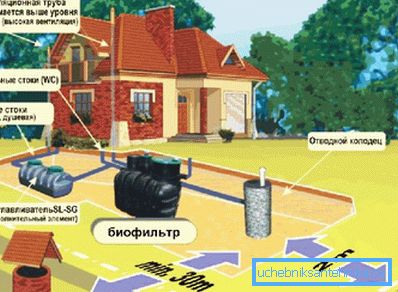
The installation of sewage is carried out in accordance with existing sanitary standards. Thanks to their observance, you will protect the house and the site from unpleasant consequences in the form of flooding with drains or their ingress into drinking water. The receiving septic tank or pit should be removed from the house by 10 m, for sealed tanks the distance can be reduced to 5 m. The distance to the well is not less than 30 m, if the soil is sandy, it is increased to 50 m. The maximum depth of the cesspool is 3 m, and it should not reach groundwater. If the water in the soil is at a high level, then only a plastic tank can be installed. In addition, it is necessary to ensure the smooth passage of the vacuum truck, because they will periodically pump out the sewage system.
External pipeline
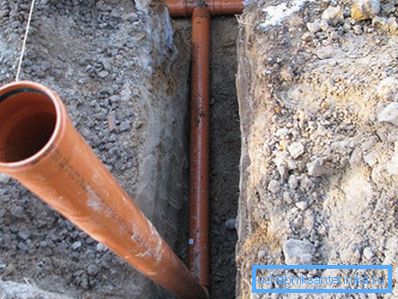
To begin the installation of pipes through which the drains will flow into the septic tank, it is necessary after its installation. Usually, polymer pipes are used for independent sewage systems, but cast iron and ceramic are suitable for this purpose. The listed materials are rarely used because of installation difficulties and high cost. If pipes from polypropylene are chosen for operation, they are placed in a concrete box. This material is brittle and may not withstand mechanical stress. When choosing a direction, turns should be avoided; they increase the likelihood of clogging. The depth of laying of external pipes is about 1 m, it increases in the northern regions. At low winter temperatures it is worth protecting the trunk with a casing of insulation.
We must not forget about the slope, which for a pipe with a section of 110 mm is 2 cm per meter. Liquids stuck in the pipeline in winter will cause sewage to freeze, so you should not ignore the rules.
At the bottom of the trench, sand is poured in a layer of 10 cm, and an orange plastic pipe designed for operation in the ground is placed on it. Between themselves, they are fastened with special couplings. Installation begins from a septic tank, the first pipe is introduced into it, and the main line is gradually brought to the place of the house entrance. After installation, the trench is filled with sand, and then with the ground.
Independent device of sewage complex and responsible process, it requires a lot of labor costs for earthworks or to attract special equipment.
Video
Thanks to this video, you will learn a lot about sewage in a country house, the sewage treatment system and the environmental problem related to water pollution:
A photo
